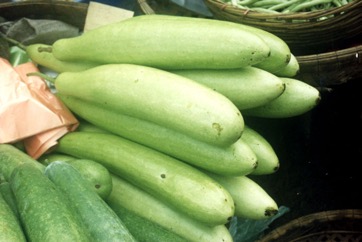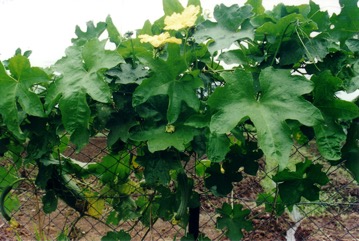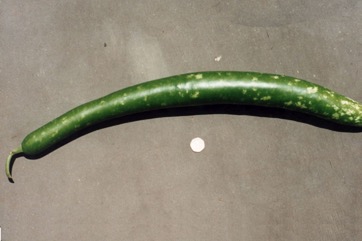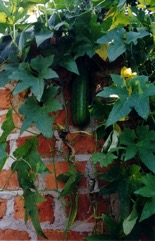Smooth loofah, Vegetable sponge

A tropical plant. It grows well in the tropical lowlands but will also grow in more temperate places. It does best with temperatures between 25-30°C. It is better suited to the drier season as too heavy a rainfall during flowering and fruiting is harmful. Soils should be well drained and moderately rich. It grows in areas with an annual rainfall between 1,000-1,800 mm. In Zimbabwe it grows up to 1,500 m above sea level. In Argentina it grows up to 1,000 m above sea level. It can grow in arid places. It suits hardiness zones 9-12. In Yunnan.
Also known as:
Belustru, Bhol, Blustru, Boap hom, Boco, Chinkupule, Chisambo, Dadar, Dhundal, Dhundol pata, Dhundul, Dirgha patolika, Dishcloth gourd, Djadar, Djadra, Dudhul, Ekyangwe, Emes, Empenche, Esfregao, Esponja vegetal, Essancadaco, Estropajo, Fuaski, Futi, Ghia-torai, Ghiu toria, Ghiya tori, Ghosali, Ghuraunla, Guthibira, Hechima, Hey, Kabatiti, Kattupeechal, Ketola manis, Kisukulio, Kyangwe, Landjirco, Lidadochi, Lipa, Lotorco, M'boa, Makwasaokwasa, Mantwatwa, Meethi-torai, Metolak, Metowo, Mozhuku pirkankai, Muop huong, Muop, Musaka saka, Nanua, Niyan-wetakolu, Nonong prakaer, Nsanu, Ntembere, Nterater, Nsanu, Ogiogi, Olok, Patola, Petola buntal, Petola manis, Petulo panjang, Pichuknu, Pipino-di-lobo, Pipino-di-mato, Pir rorogo, Poente, Pronthai, Rajakoshataki, Saysay-ot, Si gua, Sponge gourd, Sze kwa, Tangmui, Tha-but-chaw, Thabut-kha, Tha-but-nwe, Thenpon, Thoraa, Toorai, Tuppahirekai, Turia, Umpawng, Vatakolu, Xifenhu
Synonyms
- Luffa aegyptiaca Miller
- Luffa aegyptiaca Miller var. peramara Bailey
- Luffa fricatoria Donde
- Luffa insularum Donde
- Luffa leucosperma M. Roem.
- Luffa pentandra Roxb.
- Luffa racemosa Roxb.
- Luffa sylvestris Miq.
- Luffa leiocarpa (Naudin) F. Muell.
- Momordica cylindrica L.
- Momordica luffa L.
Edible Portion
- Fruit, Leaves, Flowers, Seeds, Seeds-oil, Vegetable
Where does Smooth loofah grow?
Found in: Africa, Andamans, Angola, Argentina, Asia, Australia, Bangladesh, Benin, Bhutan, Brazil, Burkina Faso, Cambodia, Cameroon, Central Africa, China, Congo DR, Cuba, Dominican Republic, East Africa, East Timor, Ethiopia, Fiji, Gambia, Ghana, Guiana, Guianas, Guinea, Guinée, Guinea-Bissau, Guyana, Haiti, Himalayas, India, Indochina, Indonesia, Japan, Kenya, Korea, Laos, Liberia, Malawi, Malaysia, Maldives, Mali, Marquesas, Mexico, Mozambique, Myanmar, Nauru, Nepal, Nigeria, North America, Northeastern India, Pacific, Pakistan, Papua New Guinea, PNG, Paraguay, Philippines, Puerto Rico, Rotuma, Rwanda, Sao Tome and Principe, SE Asia, Senegal, Sierra Leone, Sikkim, Solomon Islands, South Africa, Southern Africa, South America, South Sudan, Sri Lanka, Sudan, Suriname, Taiwan, Thailand, Timor-Leste, Togo, Tonga, Tuvalu, Uganda, Vanuatu, Venezuela, Vietnam, West Africa, West Indies, Zambia, Zimbabwe
Notes: There are 6 Luffa species. Chemical composition (Chinese sample): Protein = 1.4%. Fat = 0.15%. Carbohydrate = 4.28%. Ash = 0.48%. Moderate quantities of Vitamins A, B1 and B2. Moderate amounts of Vitamin C. Seed oil (Zambian sample): oil = 16%. Component esters (wt%): 16:0 = 16%. 18:0 = 13%. 18:1 = 14%. 18:2 = 3%.
Status: It is a commercially cultivated vegetable. In Papua New Guinea a minor vegetable seen in several coastal areas.
Growing Smooth loofah, Vegetable sponge
Cultivation: Plants are grown from seed. Seed are collected from ripe fruit. Seed are sown 4-5 cm deep and plants are put 1 metre apart. They can be sown in seed boxes and transplanted when 15 cm high. It is best to have a trellis for the plant to climb on or be left to climb over trees. They are often pollinated by insects but can be hand pollinated in the early morning.
Edible Uses: The young fruit are cooked and eaten as a vegetable. They are skinned and have the centre removed. They can also be sliced and dried for later use. They can be pickled or used in soups, stews and curries. The seeds yield an edible oil after extraction. The seeds are roasted with salt and eaten as a snack. The young leaves and flowers are edible. They are blanched by covering to make them white. CAUTION Older fruit are bitter and fibrous and contain poisonous substances.
Production: Fruit are harvested for sponges when fully mature. Young fruit are ready 2-3 months after planting while fruit mature 4-5 months after planting. For eating, young fruit are used. One plant can produce 20-25 fruit.
Nutrition Info
per 100g edible portion| Edible Part | Energy (kcal) | Protein (g) | Iron (mg) | Vitamin A (ug) | Vitamin c (mg) | Zinc (mg) | % Water |
|---|---|---|---|---|---|---|---|
| Seeds | - | - | - | - | - | - | |
| Fruit | 19 | 1.1 | 0.7 | - | - | - | 94.3 |
| Leaves | 27 | 5.1 | 11.5 | - | 95 | - | 90 |
Smooth loofah, Vegetable sponge Photos




References
Achigan-Dako, E, et al (Eds), 2009, Catalogue of Traditional Vegetables in Benin. International Foundation for Science. (As Luffa aegyptiaca)
Ali, A. M. S., 2005, Homegardens in Smallholder Farming Systems: Examples from Bangladesh. Human Ecology, Vol. 33, No. 2 pp. 245-270
Altschul, S.V.R., 1973, Drugs and Foods from Little-known Plants. Notes in Harvard University Herbaria. Harvard Univ. Press. Massachusetts. no. 4369
Ambasta, S.P. (Ed.), 2000, The Useful Plants of India. CSIR India. p 339
Ara, R. I. T., 2015, Leafy Vegetables in Bangladesh. Photon eBooks. p 149
Arora, R. K., 2014, Diversity in Underutilized Plant Species - An Asia-Pacific Perspective. Bioversity International. p 48
Asfaw, Z., Conservation and use of traditional vegetables in Ethiopia. FAO
Asfaw, Z. and Tadesse, M., 2001, Prospects for Sustainable Use and Development of Wild Food Plants in Ethiopia. Economic Botany, Vol. 55, No. 1, pp. 47-62
Bandyopadhyay, S., et al, 2012, A Census of Wild Edible Plants from Howrah District, West Bengal, India. Proceedings of UGC sponsored National Seminar 2012
Banerjee, A., et al, 2013, Ethnobotanical Documentation of Some Wild Edible Plants in Bankura District, West Bengal, India. The Journal of Ethnobiology and Traditional Medicine. Photon 120 (2013) 585-590
Bodkin, F., 1991, Encyclopedia Botanica. Cornstalk publishing, p 655
Bodkin, F., 1991, Encyclopedia Botanica. Cornstalk publishing, p 655 (As Luffa aegyptiaca)
Bodner, C. C. and Gereau, R. E., 1988, A Contribution to Bontoc Ethnobotany. Economic Botany, 43(2): 307-369
Bremness, L., 1994, Herbs. Collins Eyewitness Handbooks. Harper Collins. p 282
Brown, D., 2002, The Royal Horticultural Society encyclopedia of Herbs and their uses. DK Books. p 266
Burkill, H. M., 1985, The useful plants of west tropical Africa, Vol. 1. Kew.
Burkill, I.H., 1966, A Dictionary of the Economic Products of the Malay Peninsula. Ministry of Agriculture and Cooperatives, Kuala Lumpur, Malaysia. Vol 2 (I-Z) p 1394
Chowdery, T., et al, 2014, Wild edible plants of Uttar Dinajpur District, West Bengal. Life Science Leaflets. 47:pp 20-36 http://lifesciencesleaflets.ning.com (As Luffa aegyptiaca)
Chowdhury, M. & Mukherjee, R., 2012, Wild Edible Plants Consumed by Local Communities of Maldah of West Bengal, India. Indian J.Sci.Res.3(2) : 163-170 (As Luffa aegyptica)
Cooper, W. and Cooper, W., 2004, Fruits of the Australian Tropical Rainforest. Nokomis Editions, Victoria, Australia. p 140
Cowie, I, 2006, A Survey of Flora and vegetation of the proposed Jaco-Tutuala-Lore National Park. Timor-Lests (East Timor) www.territorystories.nt/gov.au p 46
Creasy, R., 2000, The Edible Asian Garden. Periplus p 46
Dansi, A., et al, 2008, Traditional leafy vegetables and their use in the Benin Republic. Genet Resour Crop Evol (2008) 55:1239–1256
Dhyani, S.K., & Sharma, R.V., 1987, Exploration of Socio-economic plant resources of Vyasi Valley in Tehri Garwhal. J. Econ. Tax. Bot. Vol. 9 No. 2 pp 299-310 (As Luffa aegyptiaca)
Elliot, W.R., & Jones, D.L., 1993, Encyclopedia of Australian Plants suitable for cultivation. Vol 6. Lothian. p 240
Esquinas-Alcazar, et al, 1983, Genetic Resources of Cucurbitaceae. International Board of Plant Genetic Resources.
Facciola, S., 1998, Cornucopia 2: a Source Book of Edible Plants. Kampong Publications, p 87
Fam. nat. syn. monogr. 2:63. 1846
Flora of Australia, Volume 8, Lecythidales to Batales, Australian Government Publishing Service, Canberra (1982) p 179
Flora of Pakistan. www.eFloras.org
Fowler, D. G., 2007, Zambian Plants: Their Vernacular Names and Uses. Kew. p 22
French, B.R., 1986, Food Plants of Papua New Guinea, A Compendium. Asia Pacific Science Foundation p 110
French, B.R., 2010, Food Plants of Solomon Islands. A Compendium. Food Plants International Inc. p 140
Gangte, H. E., et al, 2013, Wild Edible Plants used by the Zou Tribe in Manipur, India. International Journal of Scientific and Research Publications, Volume 3, Issue 5
Goode, P., 1989, Edible Plants of Uganda. FAO p 26
Ghosh, A, 2014, Survey of Ethno-medicinal Climbing plants in Andaman and Nicobar Islands, India. Int. J. of Pharm. Life Sci. 5(7): July, 2014:3671-3677
Grivetti, L. E., 1980, Agricultural development: present and potential role of edible wild plants. Part 2: Sub-Saharan Africa, Report to the Department of State Agency for International Development. p 47
Grubben, G. J. H. and Denton, O. A. (eds), 2004, Plant Resources of Tropical Africa 2. Vegetables. PROTA, Wageningen, Netherlands. p 563
Guite, C., 2016, A study of wild edible plants associated with the Paite tribe of Manipur, India, International Journal of Current Research. Vol. 8, Issue, 11, pp. 40927-40932
GUNSTONE et al,
Hedrick, U.P., 1919, (Ed.), Sturtevant's edible plants of the world. p 388 (As Luffa aegyptiaca)
Henty, E.E., 1980, Harmful Plants in Papua New Guinea. Botany Bulletin No 12. Division Botany, Lae, Papua New Guinea. p 44
Hu, Shiu-ying, 2005, Food Plants of China. The Chinese University Press. p 707 (As Luffa aegyptiaca)
IRVINE,
Jacquat, C., 1990, Plants from the Markets of Thailand. D.K. Book House p 55
Jardin, C., 1970, List of Foods Used In Africa, FAO Nutrition Information Document Series No 2.p 87
Kays, S. J., and Dias, J. C. S., 1995, Common Names of Commercially Cultivated Vegetables of the World in 15 languages. Economic Botany, Vol. 49, No. 2, pp. 115-152 (As Luffa aegyptiaca)
Khanal, R., et al, 2014, Documenting abundance and use of underutilized plant species in the mid hill region of Nepal. ECOPRINT 21: 63-71, 2014
Kiple, K.F. & Ornelas, K.C., (eds), 2000, The Cambridge World History of Food. CUP p 1719 (As Luffa aegyptiaca)
Koni, J. M. & Bostein, K., 2008, Noms et usages des plantes utiles chez les Nsong, DR Congo. University of Gothenburg. Department of Oriental and African Languages.
Kumar, A., et al, 2012, Ethnobotanical Edible Plant Biodiversity of Lepcha Tribes. Indian Forester, 138 (9):798-803
Kuo, W. H. J., (Ed.) Taiwan's Ethnobotanical Database (1900-2000), http://tk.agron.ntu.edu.tw/ethnobot/DB1.htm
Larkcom, J., 1991, Oriental Vegetables, John Murray, London, p 81
Latham, P & Mbuta, A., 2017, Useful Plants of Central Province, Democratic Republic of Congo. Volume 2. Salvation Army p 3
Lazarides, M. & Hince, B., 1993, Handbook of Economic Plants of Australia, CSIRO. p 152
Lazarides, M. & Hince, B., 1993, Handbook of Economic Plants of Australia, CSIRO. p 152 (As Luffa aegyptiaca)
Liu, Yi-tao, & Long, Chun-Lin, 2002, Studies on Edible Flowers Consumed by Ethnic Groups in Yunnan. Acta Botanica Yunnanica. 24(1):41-56
Llamas, K.A., 2003, Tropical Flowering Plants. Timber Press. p 183
Lulekal, E., et al, 2011, Wild edible plants in Ethiopia: a review on their potential to combat food insecurity. Afrika Focus - Vol. 24, No 2. pp 71-121
Macmillan, H.F. (Revised Barlow, H.S., et al) 1991, Tropical Planting and Gardening. Sixth edition. Malayan Nature Society. Kuala Lumpur. p 335 (As Luffa aegyptiaca)
Maghirang, R. G., et al, 2018. Ethnobotanical Studies of Some Plants Commonly Used as Vegetables in Selected Provinces of the Philippines. Journal of Nature Studies. 17(2), 30-43.
Malaisse, F., 1997, Se nourrir en floret claire africaine. Approche ecologique et nutritionnelle. CTA., p 91.
Manandhar, N.P., 2002, Plants and People of Nepal. Timber Press. Portland, Oregon. p 300
Martin, M.A., 1971, Introduction L'Ethnobotanique du Cambodge. Centre National de la Recherche Scientifique. Paris.
Medhi, P. & Borthakur, S. K., 2012, Phytoresources from North Cachur Hills of Assam -3: Edible plants sold at Hflong market. Indian Journal or Natural Products and Resources. 3(1) pp 84-109
Menisa, A. A., et al, 2012, Survey and characterization of Indigenous Food Plants in Ilocos Norte, Philippines. SEARCA Discussion Paper series No. 2011-2
Miguel, E., et al, 1989, A checklist of the cultivated plants of Cuba. Kulturpflanze 37. 1989, 211-357
Murtem, G. & Chaudhrey, P., 2016, An ethnobotanical note on wild edible plants of Upper Eastern Himalaya, India. Brazilian Journal of Biological Sciences, 2016, v. 3, no. 5, p. 63-81 (As Luffa aegyptiaca)
Norrington, L., & Campbell, C., 2001, Tropical Food Gardens. Bloomings Books. p 47
Ochse, J.J. et al, 1931, Vegetables of the Dutch East Indies. Asher reprint. p 203
Okigbo, B.N., Vegetables in Tropical Africa, in Opena, R.T. & Kyomo, M.L., 1990, Vegetable Research and development in SADCC countries. Asian Vegetable Research and development Centre. Taiwan. p 38
Omawale, 1973, Guyana's edible plants. Guyana University, Georgetown p 97
Ong, H., et al, 2012, Traditional knowledge and usage of edible plants among the Semai community of Kampung Batu 16, Tapah, Perak, Malaysia. Scientific Research and Essays Vol. 7(4), pp. 441-445, 30 January, 2012 (As Luffa aegyptiaca)
Owen, S., 1993, Indonesian Food and Cookery, INDIRA reprints. p 76
Paczkowska, G. & Chapman, A.R., 2000, The Western Australian Flora. A Descriptive Catalogue. Western Australian Herbarium. p 221
Peekel, P.G., 1984, (Translation E.E.Henty), Flora of the Bismarck Archipelago for Naturalists, Division of Botany, Lae, PNG. p 543, 544
Peters, C. R., O'Brien, E. M., and Drummond, R.B., 1992, Edible Wild plants of Sub-saharan Africa. Kew. p 102
Pham-Hoang Ho, 1999, An Illustrated Flora of Vietnam. Nha Xuat Ban Tre. p 569
Phon, P., 2000, Plants used in Cambodia. © Pauline Dy Phon, Phnom Penh, Cambodia. p 409 (As Luffa aegyptiaca)
Plants of Haiti Smithsonian Institute http://botany.si.edu/antilles/West Indies (As Luffa aegyptiaca)
Purseglove, J.W., 1968, Tropical Crops Dicotyledons, Longmans. p 129
Rashid, H. E., 1977, Geography of Bangladesh. Westview. p 263 (As Luffa aegyptica)
READ,
Royal Botanic Gardens, Kew (1999). Survey of Economic Plants for Arid and Semi-Arid Lands (SEPASAL) database. Published on the Internet; http://www.rbgkew.org.uk/ceb/sepasal/internet [Accessed 16th April 2011]
Rubaihayo, E. B., Conservation and use of traditional vegetables in Uganda. Bioversity International.
Ruiters-Welcome, A. K., 2019, Food plants of southern Africa. Ph.D. thesis. Univ. of Johannesburg p 50
Sharma, B.B., 2005, Growing fruits and vegetables. Publications Division. Ministry of Information and broadcasting. India. p 181
Sher, Z., Hussain, F., & Ibrar, M., 2014, Traditional knowledge on plant resources of Ashezai and Salarzai Valleys, District Buner, Pakistan. African Journal of Plant Science. Vol. 8(1), pp. 42-53, January 2014
Siemonsma, J. S. and Piluek, K. (Eds), 1994, Plant Resources of South-East Asia No. 8 Vegetables. Prosea Foundation, Bogor, Indonesia, p 194 (As Luffa aegyptiaca)
Smith, P.M., 1979, Smooth loofah, in Simmonds, N.W., (ed), Crop Plant Evolution. Longmans. London. p 306
Solomon, C., 2001, Encyclopedia of Asian Food. New Holland. p 176
Srivastava, R. C., 2010, Traditional knowledge of Nyishi (Daffla) tribe of Arunachal Pradesh. Indian Journal of Traditional Knowledge. 9(1):26-37
Staples, G.W. and Herbst, D.R., 2005, A tropical Garden Flora. Bishop Museum Press, Honolulu, Hawaii. p 268 (As Luffa aegyptiaca)
Sujanapal, P., & Sankaran, K. V., 2016, Common Plants of Maldives. FAO & Kerala FRI, p 169
Terra, G.J.A., 1973, Tropical Vegetables. Communication 54e Royal Tropical Institute, Amsterdam, p 57
Terashima, H., et al, 1992, Ethnobotany of the Lega in the Tropical Rainforest of Eastern Zaire (Congo): Part Two, Zone de Walikale, African Study Monographs, Suppl. 19:1-60
Thaman, R. R, 2016, The flora of Tuvalu. Atoll Research Bulletin No. 611. Smithsonian Institute p 82
Thothathri, K., & Pal, G.D., 1987, Further Contribution to the Ethnobotany of Subansiri District, Aranchal Pradesh. J. Econ. Tax. Bot. Vol. 10 No. 1 pp 149-157
Tindall, H.D., 1983, Vegetables in the tropics. Macmillan p. 176
Tindall, H.D., & Williams, J.T., 1977, Tropical Vegetables and their Genetic Resources, International Board for Plant Genetic Resources, Rome, p 51 (As Luffa aegyptiaca)
Tronickova, E. & Krejcova, Z., 1987, Ortaggi, Instituto Geografico de Agostini, Cecoslovacchia. p 154
UPHOF,
Van Sam, H. et al, 2008, Uses and Conservation of Plant Species in a National Park. A case study of Ben En, Vietnam. Economic Botany 62:574-593 (As Luffa aegyptiaca)
van Wyk, Be., & Gericke, N., 2007, People's plants. A Guide to Useful Plants of Southern Africa. Briza. p 48
Walters, T. W., 1989, Historical Overview on Domesticated Plants in China with Special Emphasis on the Cucurbitaceae. Economic Botany 43(3): 297-313
Wheeler, J.R.(ed.), 1992, Flora of the Kimberley Region. CALM, Western Australian Herbarium, p 250
Wijayakusuma, H.M.H., et al, 1996, Tanaman Berkhasiat Obat Di Indonesia. Pustaka Kartini. p 29 (As Luffa aegyptiaca)
Williamson, J., 2005, Useful Plants of Malawi. 3rd. Edition. Mdadzi Book Trust. p 150
Woodward, P., 2000, Asian Herbs and Vegetables. Hyland House. p 90
World Checklist of Useful Plant Species 2020. Royal Botanic Gardens, Kew (As Luffa aegyptiaca)
Yeshi, K. et al, 2017, Taxonomical Identification of Himalayan Edible Medicinal Plants in Bhutan and the Phenolic Contents and Antioxidant Activity of Selected Plants. TBAP 7 (2) 2017 pp 89 - 106 (As Luffa aegyptiaca)
Yuncker, T.G., 1959, Plants of Tonga, Bernice P. Bishop Museum, Hawaii, Bulletin 220. p 260